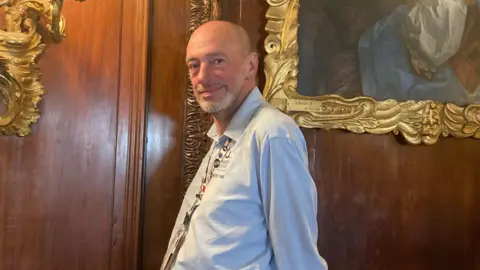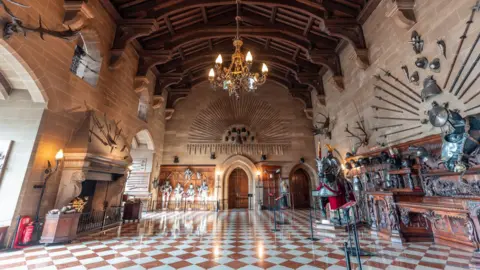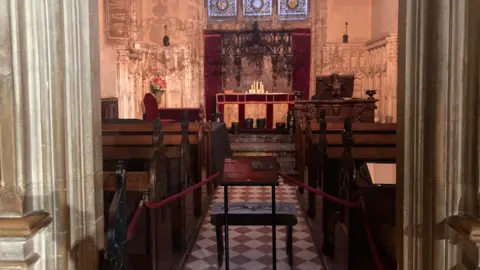Castle 'restored on the cheap' after 1871 fire
In December 1871, fire tore through Warwick's medieval castle, reducing its magnificent entrance hall and private apartments to ashes.
"The servants were woken up with what they thought was hail and in fact it was molten lead dripping off the roof into the river beneath," said castle historian Andrew Lilwall-Smith.
Perennially strapped for cash, owners the Greville family took out an advert in their local paper begging for funds.
The townsfolk, with the help of Queen Victoria, raised the monumental sum of £750,000 to restore the fire-ravaged rooms, about £76.5m in today's money.
But, despite the castle's appearance of grandeur today, the fourth earl of Warwick, Lord George, and his wife, Lady Anne, secretly cut more than a few corners.
"It is a deception from beginning to end," Mr Lilwall-Smith said.
Aspects of the castle's hidden past are being revealed for the BBC's Secret Warwickshire series.
So, how had the Grevilles gone from extreme riches to near ruin?
The story spans generations, with the family taking ownership of the castle two centuries previously, spending millions restoring it and acquiring new treasures.
As the years went by, their coffers dwindled by way of "incredible degrees of shopping", particularly during the lifetime of the second earl, Lord George, who died in 1816.
"His nickname was Golden George," said Mr Lilwall-Smith. "Two rules which he lived: Number one, if it doesn't move, gild it. Number two, if it's not nailed down, buy it.
"He gets so bad he actually opens the doors to the public, one of the first houses ever to do so... in those days that was considered quite a scandalous thing to do."
 BBC/Richard Williams
BBC/Richard WilliamsFast forward to 1871, and it is not clear how the fire began. The earl and countess were not there, although their children were. Servants grabbed what they could, but numerous items were lost.
"The only reason there's any house at all is the ceiling caved in and that is a very strong wall so the fire went up rather than along," the historian explained.
Armed with the spoils of their crowdfunding, the Grevilles set to work restoring their private apartments. But, when it came to the rest of the building, the cash soon ran out.
"They realised they didn't have enough money," he said. "They had to basically do it on the cheap, making sure none of their friends realised."
 Warwick Castle
Warwick CastleThe castle's largest room, the Great Hall, and adjoining state dining rooms were built to host kings and queens and nobles.
But the height of the Great Hall's 57ft (17.3m) ceiling was "nothing to do with architectural majesty".
"This is the cheapest wood they can lay their hands on," Mr Lilwall-Smith said. "It's basically 1800s MDF. If it was any lower down you'd know it was ghastly but up there you go 'wow'."
What appears to be sandstone on the walls is actually cladding, with burned shells remaining underneath.
And ammonite fossils in the hall's floor give away that it is limestone, rather than more expensive marble.
"Worse still, this is the old floor, turned upside down and rebuffed," he added. "The very badly-damaged pieces are simply tucked in corners where no one's going to see them.
"The very, very badly-damaged ones were cut into pieces and used to pave the chapel."
 BBC/Richard Williams
BBC/Richard WilliamsThe Grevilles used smoke and mirrors to bedazzle their guests, opening all the doors in a corridor to make it appear longer. They would retire for a spell after dinner to a drawing room, so the ballroom would subsequently seem bigger.
While it may seem deceitful, "it's what everyone was doing," said the historian. "It's all about one-upmanship."
The family's financial woes continued to plague them until 1978, when the castle was sold to the Tussaud's group to begin a new phase as a visitor attraction.
Follow BBC Coventry & Warwickshire on BBC Sounds, Facebook, X and Instagram.
